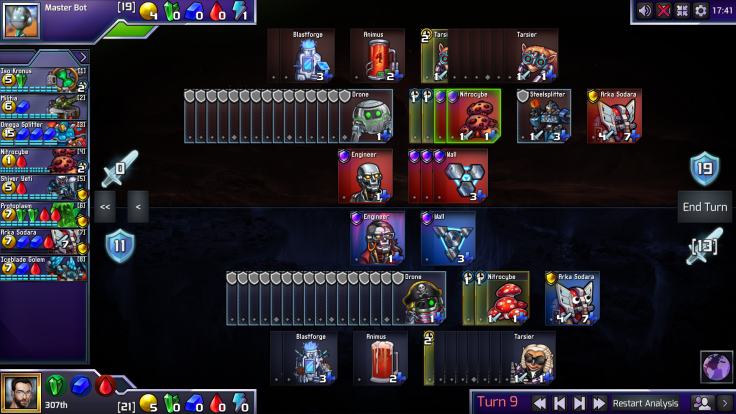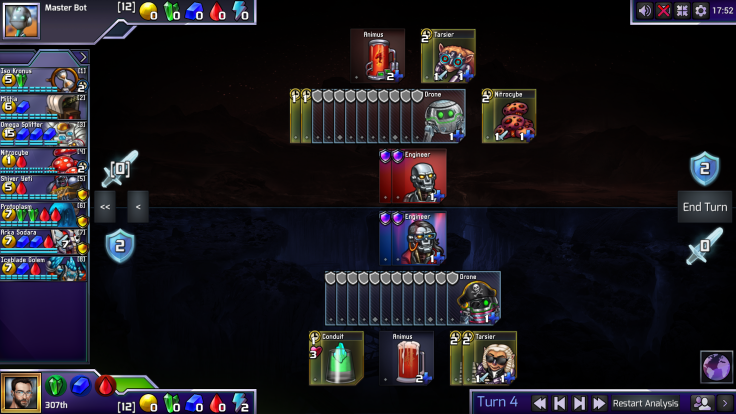It’s another set reading Saturday! Also, I’ll be starting a series of posts on breachproof (probably around five posts long) tomorrow. Here’s the set, which we’ll be playing from the perspective of player 1:

There’s three different absorbers: Omega Splitter, Protoplasm, and Arka Sodara. My approach with Arka Sodara is to ignore it at first, and see how the strategies would play out without it in the set, and then take it into account afterwards and see what (if any) modifications are needed. So let’s focus on Omega Splitter versus Protoplasm.
Omega Splitter is, overall, a much more powerful absorber than Protoplasm. In my absorber rankings, Omega came in near the top of B tier, while Protoplasm was stuck in C tier slightly above Wall. However, Omega is generally pretty clunky. First off, it requires three Blastforges to get; this is often a problem, because it usually requires you to use Blue for everything – attack and defense alike. In a set without much Blue support – like this one – you can run out of Wall supplies, which is a disaster, and you also find yourself having to make Steelsplitters (or Militia) for attack, which is also kind of a disaster.
On top of that, Omega Splitter is vulnerable to repeatable Chill, like Shiver Yeti or Iceblade Golem. These units don’t hard counter Omega Splitter, but they certainly give it a headache. So, I would guess that a Protoplasm-centred strategy should be able to beat an Omega Splitter-centred strategy.
So, our current plan is to use Protoplasm as our absorber. Let’s flesh that strategy out a bit more. Since Protoplasm isn’t a particularly powerful absorber, we’re aiming for a medium-low economy – think somewhere between twelve and sixteen Drones – with an Animus and two Conduits, for a Protoplasm per turn. Since a Protoplasm per turn only costs 7 Gold, we have room for more tech. What additional tech should we go for?
It might seem like red-green has all the bases covered, since we have access to both good attackers and Protoplasm for absorb. However, one thing red-green is missing is good soak. Because red and green are lacking in easy, efficient soak, a Blastforge seems good here – not only will it help us out with soak by allowing us to make Walls, but we can also potentially absorb on Walls in the early game if it’s more convenient than absorbing on Protoplasm (for example, if we’re facing exactly 2 damage).
So, we know the rough strategy we’d go for without Arka in the set – Green-Blue-Red, with a focus on Protoplasm for absorb, Walls for soak, and various options for attack like Tarsiers, Iso Kronus, Shiver Yeti, and Iceblade Golem. How does Arka Sodara change this?
Arka Sodara’s a weird unit. I went into the theory behind it a little bit in my absorber rankings, but the basic idea is that despite being extremely powerful, it has a low impact on sets compared to other absorbers because an Arka Sodara can be countered by a second Arka Sodara.

There is more to be said about Arka – a first Arka that gets countered isn’t always bad, for example – but I think a good default approach to Arka is to assume that an uncountered Arka Sodara is game-winning, but a countered Arka Sodara is usually not very good, and so all you need to do is make sure that if your opponent threatens Arka, you can threaten a counter-Arka.
Because of this, my approach in this set would simply be to make sure that I was able to threaten a counter-Arka if necessary, and otherwise ignore it. Since we’ll already be on Green-Blue-Red, if our opponent threatens Arka Sodara, it won’t be too difficult to throw down a second Blastforge in order to threaten a counter. So I’ll play the set as if Arka doesn’t exist, besides watching my opponent’s setup to see if they’re planning for Arka.
So now that we can ignore both Arka Sodara and Omega Splitter, we can get to the nitty gritty of the set. How should we kick off our attack? Iso Kronus, Militia, and Tarsiers are all good possibilities. Of the three, Tarsiers are best, but require us to commit to an Animus first, which can be dangerous in a Protoplasm set, since damage numbers can jump up quickly. Fortunately in this set there’s Nitrocybe, which should make transitioning from red into green-blue-red a lot smoother. Because of this, I’d favour Natural Animus. If Nitrocybe wasn’t in the set, I would probably want to go Slow Conduit.
The key to pulling off a Natural Animus build without dying to Protoplasm will be to watch our opponent like a hawk. We want to see how aggressive our opponent is – if they’re going for fast attack, we’ll want to get our defensive tech (green or blue) up quickly, while if they’re going for a slower build, we can be greedier, putting off defensive tech in favour of getting Tarsiers.

We’ll also want to watch for whether our opponent is going to go to 2 damage and then 4 – for example, if they build two Tarsiers and then two more – or whether they’re going for 1 damage and then 3.
If they’re going 2 damage first, it’s best to start off by absorbing on a Wall, meaning that we’ll want to get our Blastforge when their Tarsiers (or Iso Kronus) is on buildtime 2.

On the other hand, if they’re going 1 damage and then 3, then we’ll want to absorb on Rhino first and then Protoplasm. This will come up if our opponent opens up 1. DD 2. DA 3. TDD.

In the situation above we will most likely stay on 12 Drones, which isn’t enough to power Wall+Protoplasm a turn comfortably – it’s enough to buy Wall plus Protoplasm, but you don’t have any breathing room to e.g. make Engineers. So in this situation we would go for three conduits and one animus, since that works better on a low economy.
The game will be extremely tactical, and it will be decided by who can react to their opponent’s play the best, and choose when to get greedy versus when to prioritize defense.
-307th
Great article, thank you for the advanced analysis.
It would be really interesting to provide a replay code of your set readings played by top-elo players (and with 2 rounds to let both players get the player 1 seed, but maybe I’m asking too much 😀 ) !
LikeLike
Glad you liked it!
Doing that would be pretty difficult, but I could do posts on games that I played on ladder, in which case I could do the analysis and then post the link to the game. I might try that in the future posts.
LikeLike